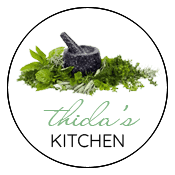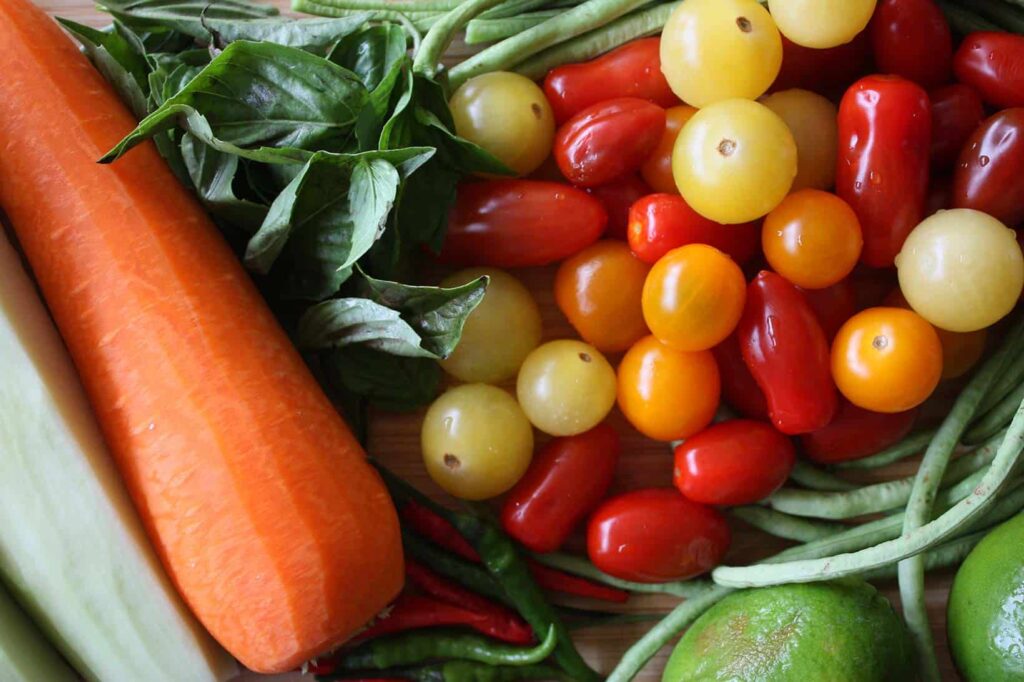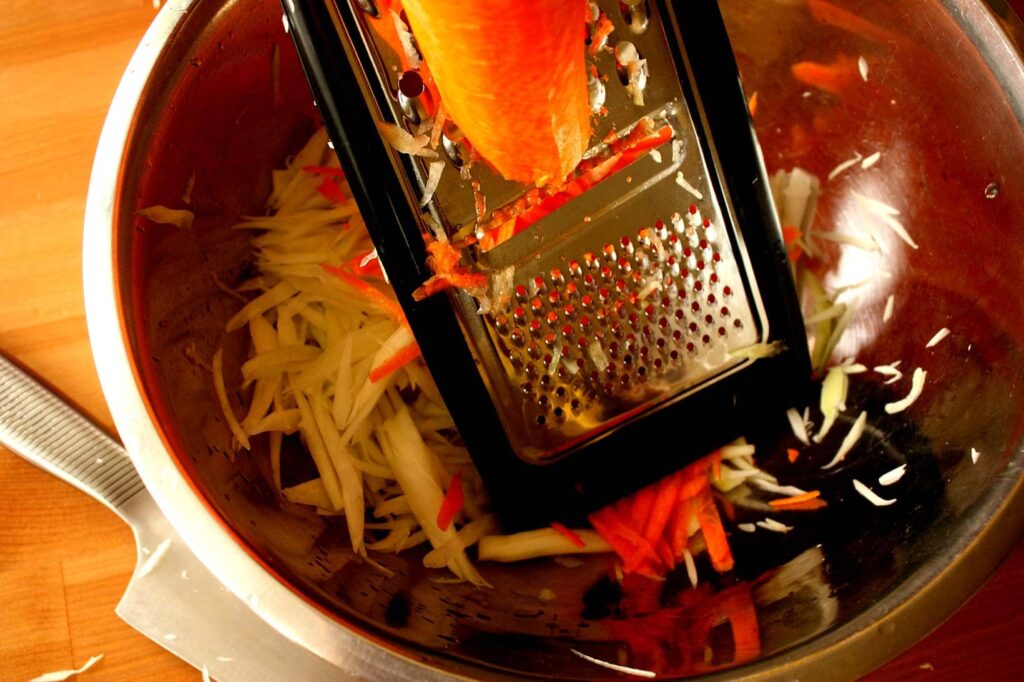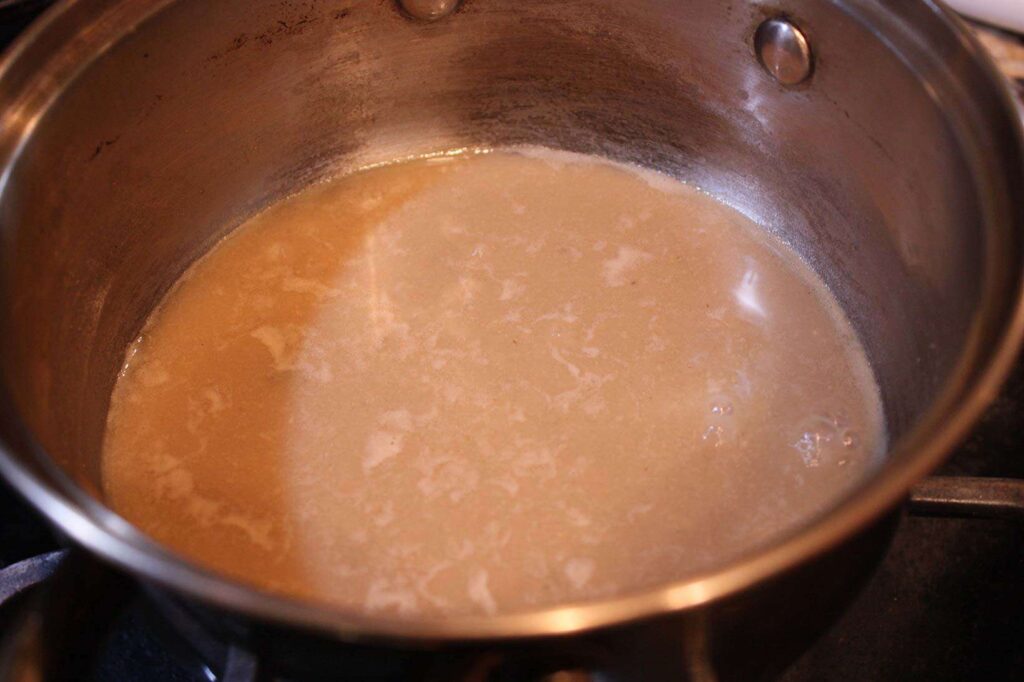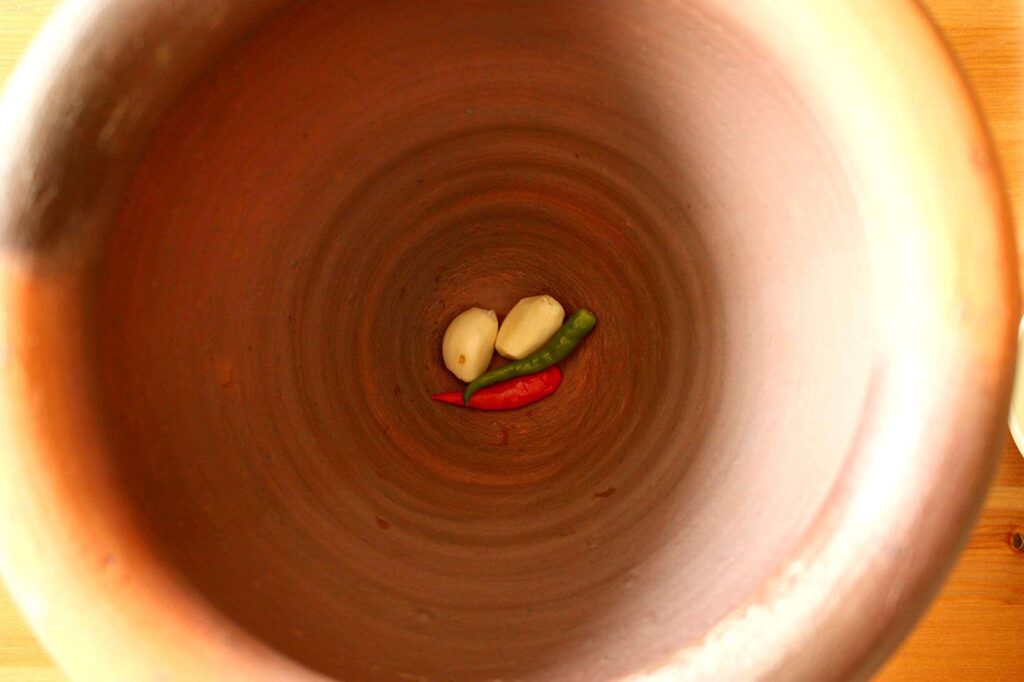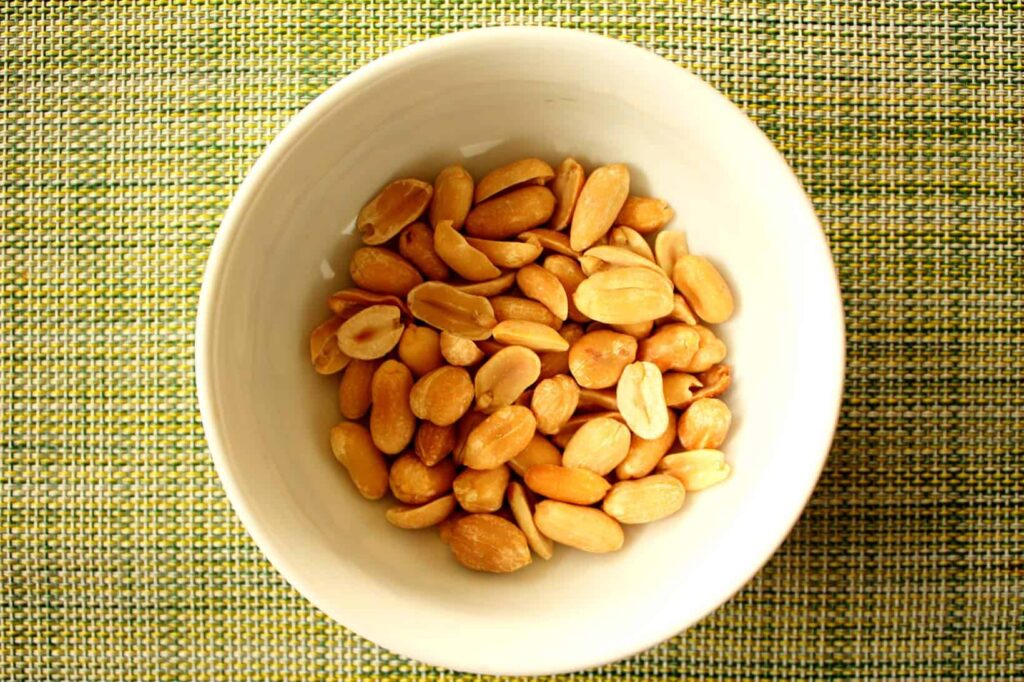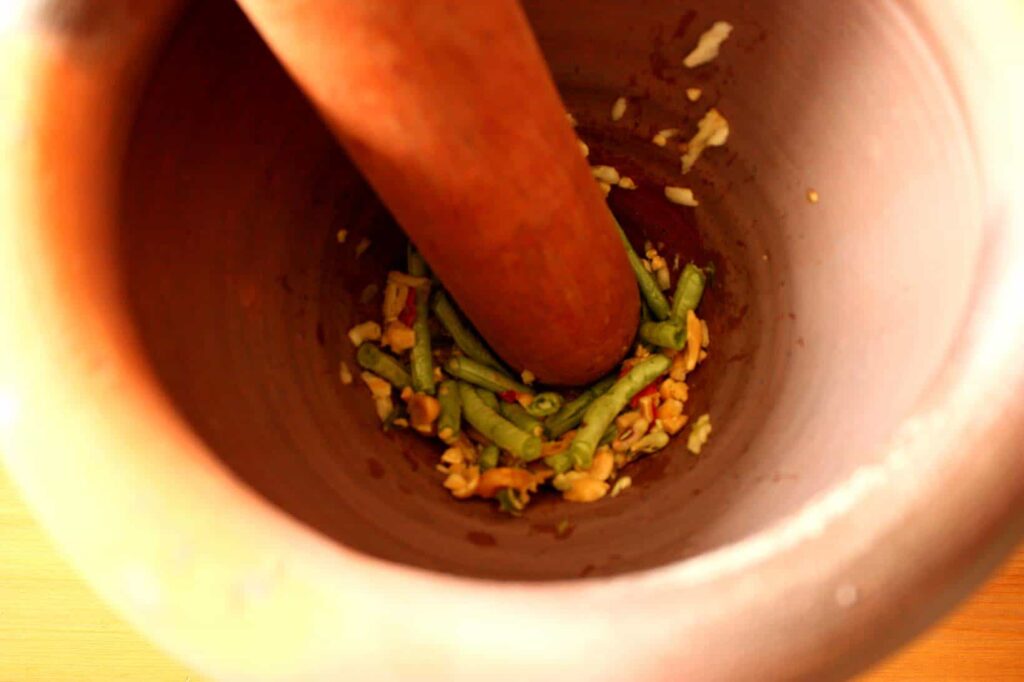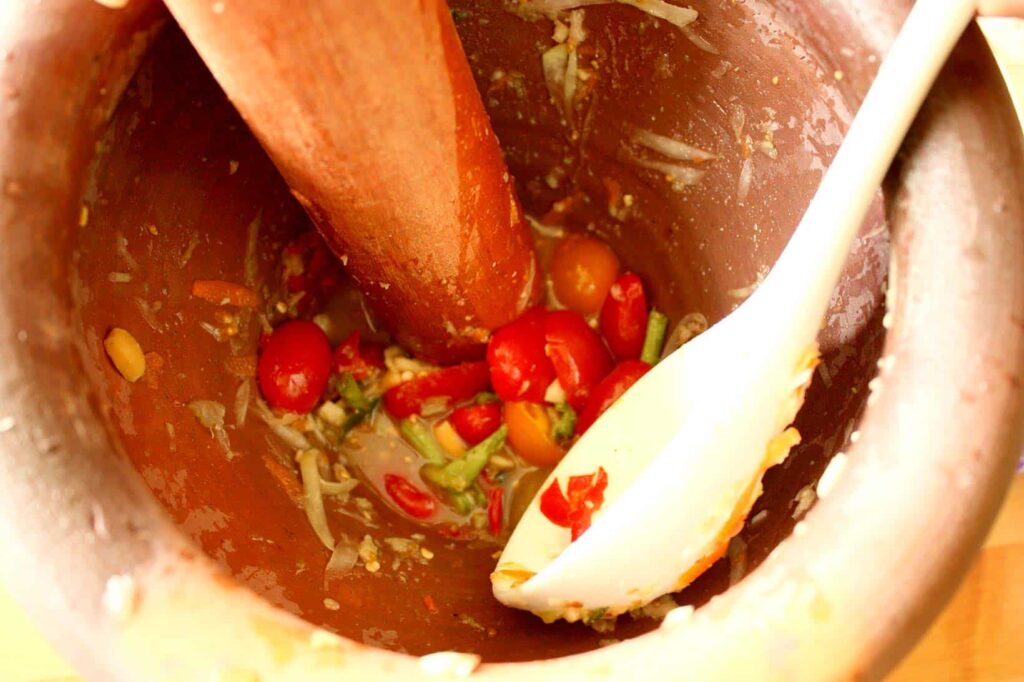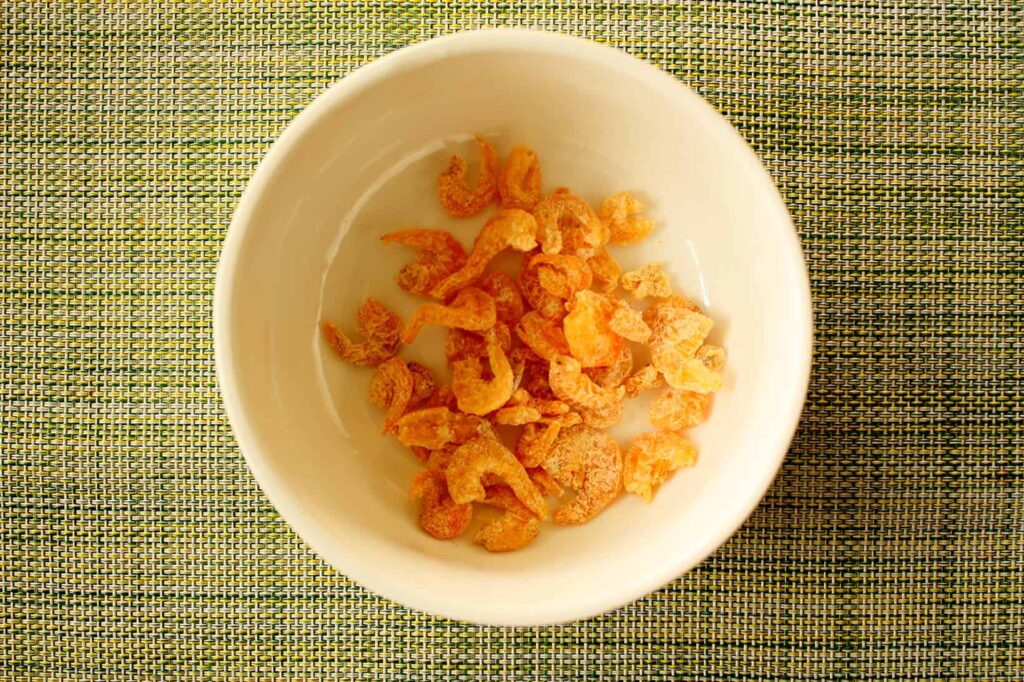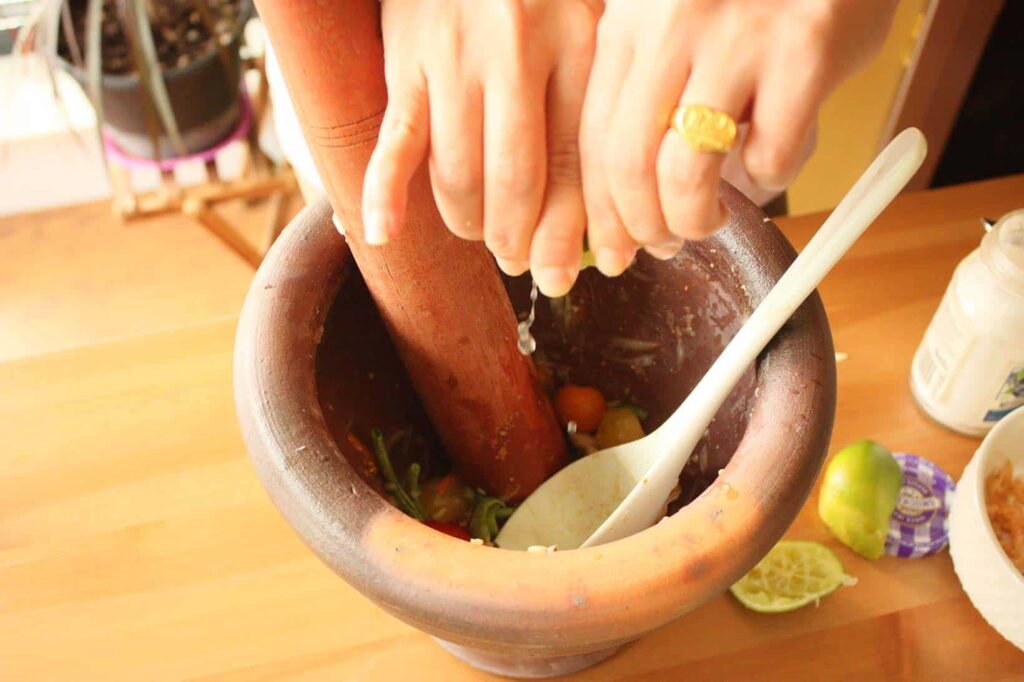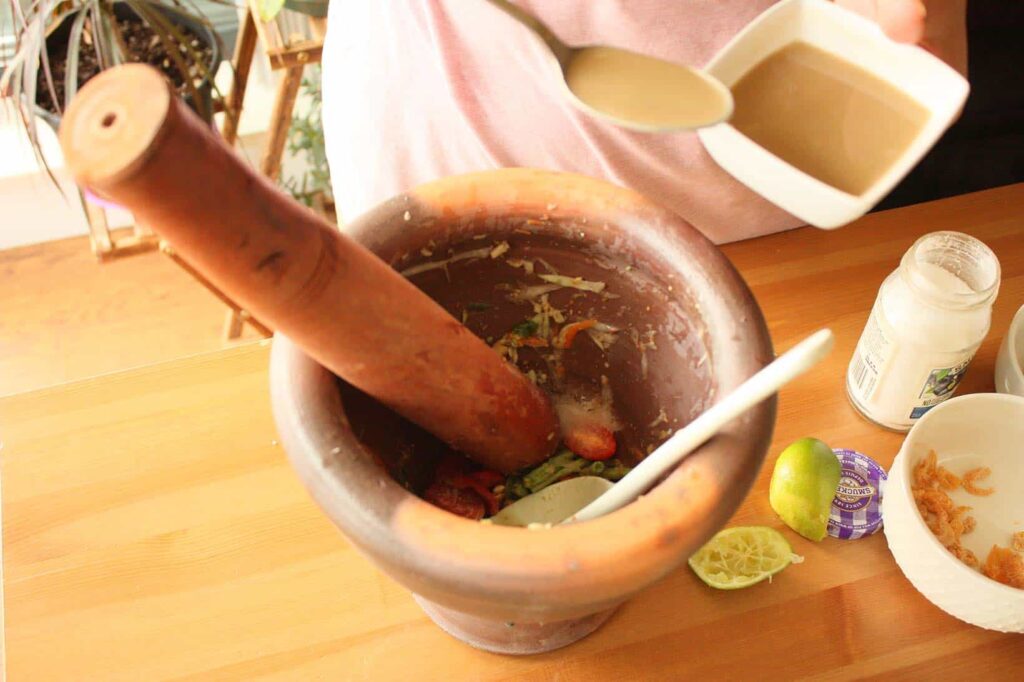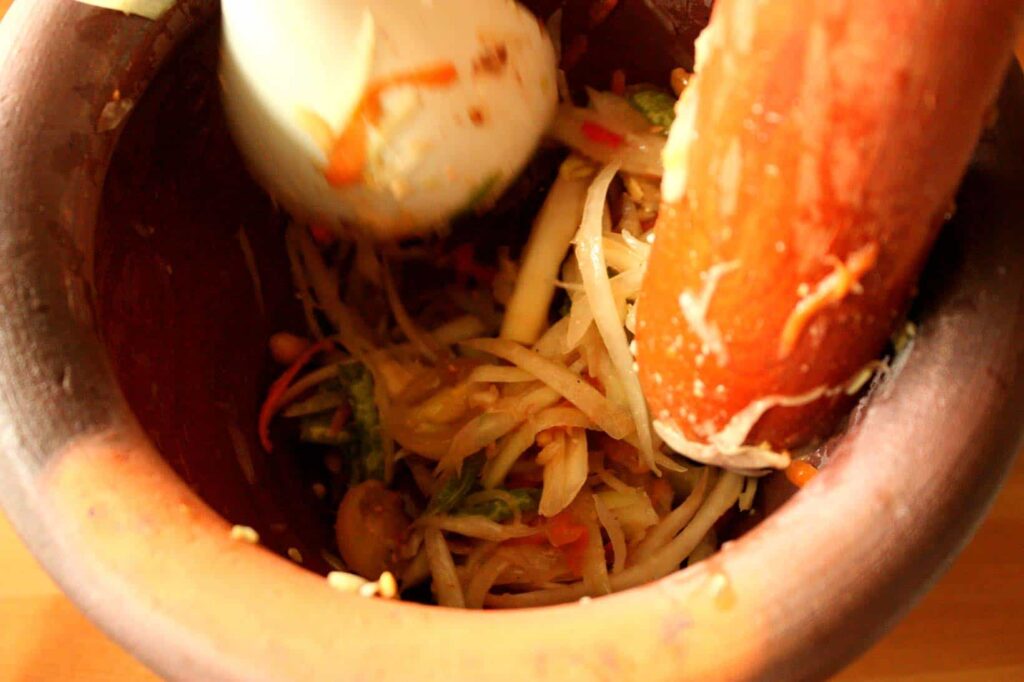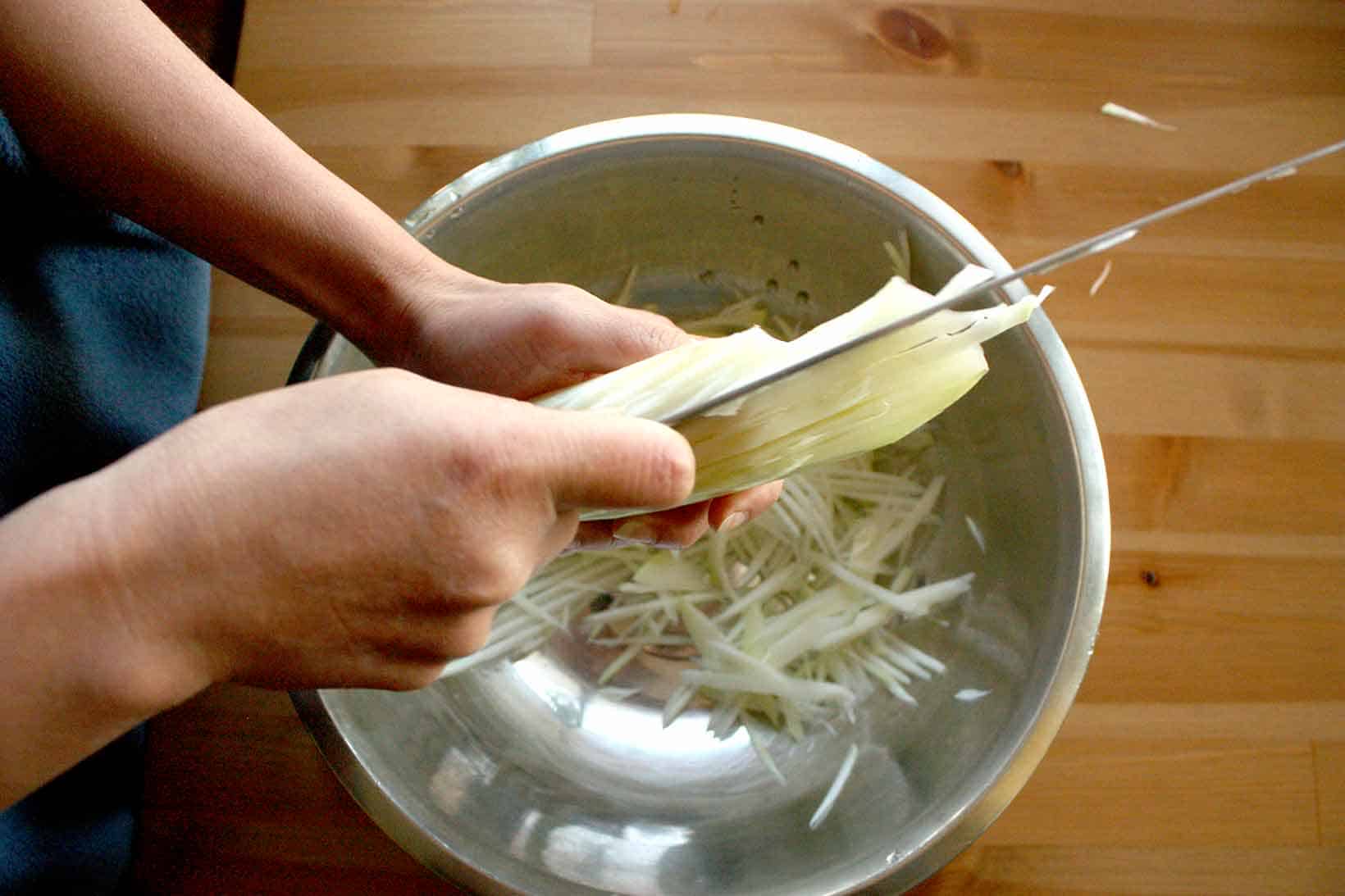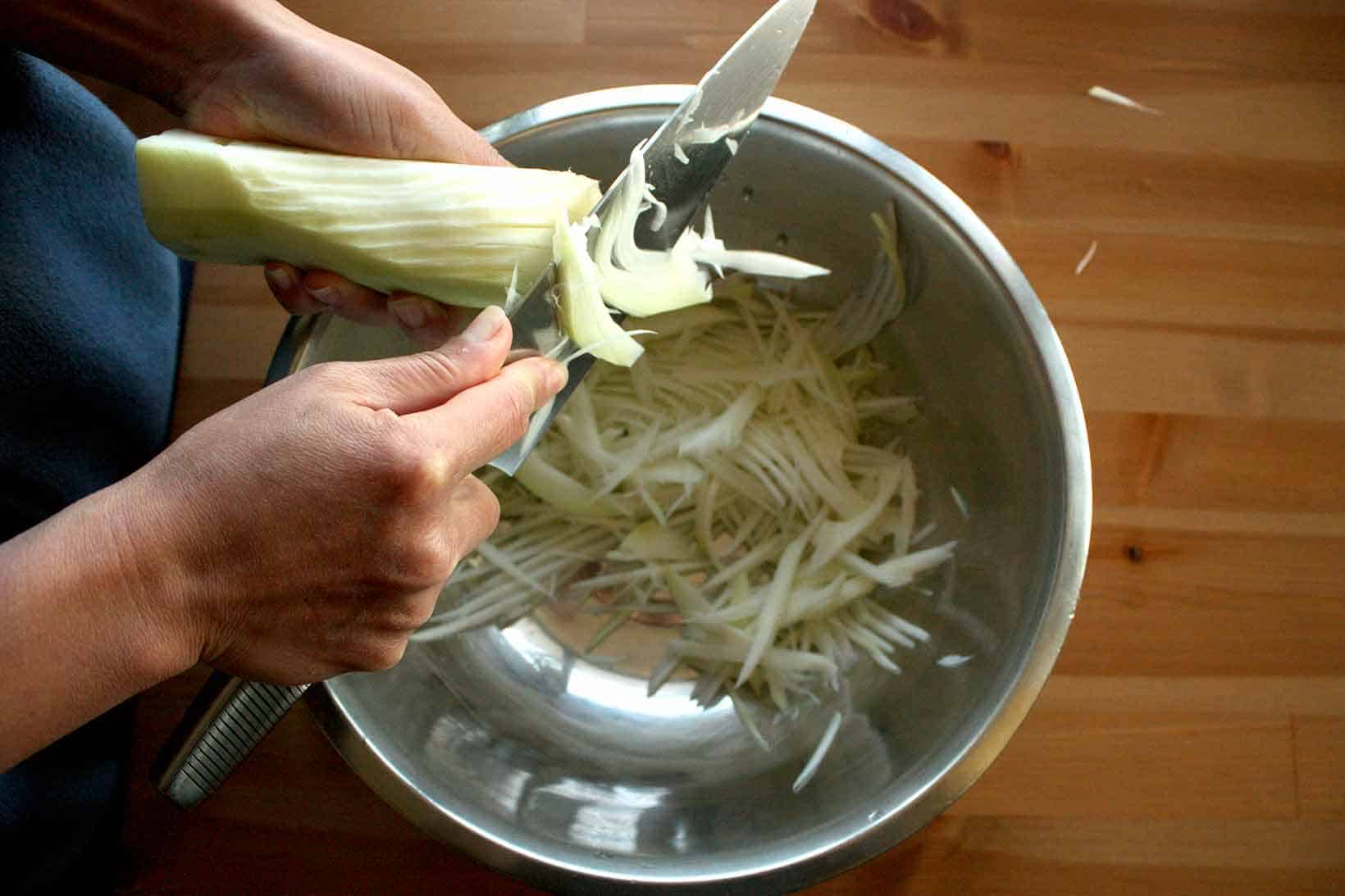Papaya salad is synonymous with Thai cuisine, and indeed, “spicy Thai papaya salad” quickly comes to mind when Thai food is mentioned. But in truth, papaya salad is the red-hot, zesty spirit of Southeast Asia itself.
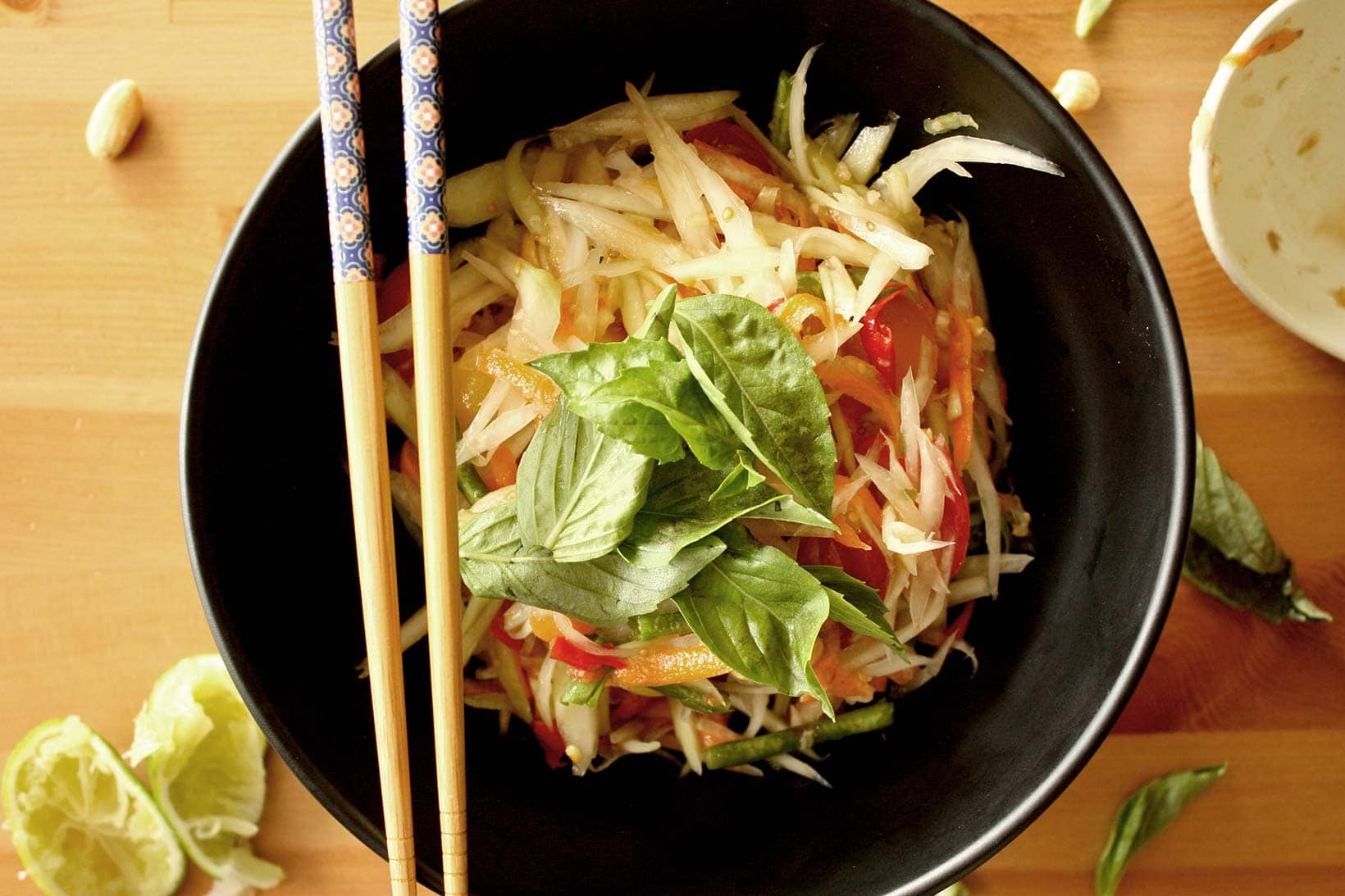
Walk down any street in Thailand, Cambodia, Laos, Myanmar, or Vietnam during the lunch or dinner hour, and you’ll find papaya salad served as fast food in any street food stall or food cart along your way. Before you see it on a sandwich board menu, however, you’ll probably hear papaya salad being made, as the sound of pestle pounding its mortar permeates the streets. The process of pounding papaya salad ingredients brings out their many complex aromas and flavours, ensures that the ingredients absorb the piquant dressing, and helps the papaya shreds retain their scrumptious crispness. In fact, local names for salad made from green unripe papaya revolve around the mortar and pestle. For example, the Thai recipe green papaya salad is called som tum; “som” means “sour,” while “tum” is an onomatopoeia for the sound the pestle makes while pounding away at the ingredients in a large mortar. Likewise, in my native Cambodia, papaya salad is called “bok lahong” — which translates as “crushed papaya,” a name that alludes to the preparation method using a mortar and pestle.
Green papaya salad is the red-hot, zesty spirit of Southeast Asia itself.
Green Papaya Salad — Essential Ingredients
Depending on which nation’s papaya salad version you’re trying, you’ll find that the main ingredients (particularly the proteins) vary slightly. For instance, classic Thai som tum is made with dried shrimp. Meanwhile, Cambodian bok lahong can be made with prahok (Cambodian fermented fish), dried shrimp and shrimp paste (kapi), or marinated crab. Despite these regional variances, the key flavours are the same for papaya salad across most of Southeast Asia. These primary flavours include the garlic’s piquancy (which you’ll smell first as the dish gets served), the tomatoes’ sweetness, the pungency of the shrimp, crab, or fermented fish, the savoury tang of the dressing, and the chillies’ scorching heat. Whether you eat papaya salad in Cambodia, Thailand, or Laos, you’ll find the crunchy texture of the ingredients is the same, too. The papaya shreds are firm and crisp; the long beans are crunchy; the tomatoes soft yet bursting with juice. To achieve this delectable balance between saltiness, sweetness, zest, and heat, and the distinct taste this balance creates, papaya salad cooks across Southeast Asia rely on a consistent selection of ingredients. Despite some regional variances in the choice of protein, unripe papaya salad typically includes green papaya, garlic, chillies, long beans (also known as “snake beans”), and grape or cherry tomatoes. These ingredients are tossed and pounded at the same time in a dressing that’s made with sugar, fish sauce, lime, and MSG.
Papaya salad ingredients should be relatively easy enough to source in US grocery stores. The most difficult component to find may be the unripe green papaya itself. While green papayas are abundant in most supermarkets in larger cities, these papayas are usually more ripe than you’ll want them to be — once you cut one open, you’ll realize that it’s already orange and somewhat ripe. Instead, you should go to an Asian supermarket and look for a papaya that’s heavy and hard to the touch. The heavier and firmer the fruit, the less ripe it is, the more suitable it is for making a papaya salad. And while you’re at the Asian market, be sure to look around for dried shrimp, shrimp paste, and fish sauce — these ingredients may also be hard to find in regular Western grocery stores. Alternatively, you can source many of these authentically Asian ingredients on Amazon and other online marketplaces.
How to Make Green Papaya Salad
Below, you’ll learn the green papaya salad recipes that are widely used in Cambodia. We’ll show you two distinct ways of preparing the papaya salad —one is with prahok (Cambodian fermented fish), and another recipe is with dried shrimp and kapi (shrimp paste). You will also learn about the different variations of unripe papaya salad, including local nuances in the salad’s Thai, Lao, Vietnamese, and Burmese varieties. Finally, we will explain where you can source your ingredients and how to find the right substitution if you must. Ready to treat yourself to a refreshing, tangy, blazing hot full meal that’s different from any other salad you’ve ever tasted? Read on!
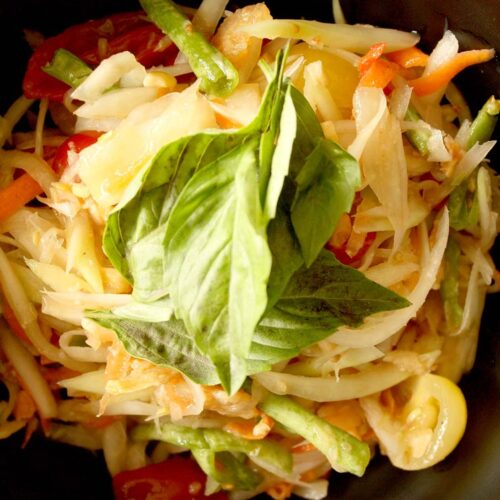
Green Papaya Salad
Equipment
- 1 Mortar and pestle (Affiliate link) — Traditionally, a clay mortar and wooden pestle is used (this is what we have). A stone or wooden mortar works well, too, as long as it's deep.
- 1 Vegetable peeler optional
- food processor optional to Mortar and pestle
Ingredients
Papaya salad base ingredients
- 2 cloves Garlic
- to taste Chilli pepper Thai chilli or bird's eye chilli as a substitution
- 1 handful Grape tomatoes Cherry tomatoes are an alternative
- ½ pound Long beans (also known as snake beans) Green beans will do as an alternative
- ½ Green papaya Must be unripe
- ½ Carrot Medium-sized
- 1 tablespoon Roasted peanuts
- 5-6 leaves Thai basil Substitute with regular basil and cilantro
Papaya salad dressing ingredients
- 1 tablespoon
Fish sauce (affiliate link) - 1 lime Lime juice Tamarind paste can be an addition or a substitution to achieve the zest
- 1 teaspoon Sugar Palm sugar is traditionally used — it gives the dressing a caramel flavour; however, white sugar works just fine.
- 1 teaspoon
MSG (affiliate link)
Variation #1 — If you want a papaya salad with kapi (shrimp paste) and dried shrimp
- 2 tablespoons
Dried shrimp (affiliate link) - ½ teaspoon
Shrimp paste (affiliate link) Firm, Thai shrimp paste — like the one at this link — works best
Variation #2 — If you want a papaya salad with prahok (fermented fish paste)
- 1 tablespoon Prahok Vietnamese version, known as Mam Ca Sac Xay, is most available outside of Southeast Asia.
- 1 cup water
Optional for Variation #1 and Variation #2
- 4 Pickled crabs Recipe coming soon!
Instructions
- Wash and peel the papaya, get rid of the seeds.½ Green papaya
- Wash and peel the carrot, then cut it in half.½ Carrot
- Wash the tomatoes, long beans, Thai basil leaves, and limes, and set aside.1 handful Grape tomatoes, ½ pound Long beans (also known as snake beans), 5-6 leaves Thai basil, 1 lime Lime juice

- Shred or grate the papaya1 coarsely.½ Green papaya

- Grate ½ of the carrot coarsely and mix with the shredded papaya.½ Carrot

- IF you're adding prahok to the papaya salad, mix the prahok with a cup of water, then bring the mixture to a boil in a small pot. Allow to simmer for 5 minutes and set aside.1 tablespoon Prahok, 1 cup water

- Place the chillies and garlic into the mortar and pound them with the pestle until achieving a paste-like consistency.2 cloves Garlic, to taste Chilli pepper

- Add the peanuts to the mortar, and pound them with the pestle.1 tablespoon Roasted peanuts

- Break the long beans into 2-inch pieces, add to the mortar, then pound lightly with the pestle to bruise the beans.½ pound Long beans (also known as snake beans)

- Half the grape (or cherry) tomatoes, add them to the mortar, and bruise gently with the pestle.1 handful Grape tomatoes

- IF you're adding dried shrimp to the papaya salad, do so now and pound the ingredients inside the mortar gently with the pestle.2 tablespoons Dried shrimp (affiliate link)

- Spinkle the sugar and MSG over the mixture in the mortar.1 teaspoon MSG (affiliate link), 1 teaspoon Sugar
- Add fish sauce to the mortar.1 tablespoon Fish sauce (affiliate link)
- Squeeze
the juice from a lime into the mortar, and mix everything together with a large spoon.1 lime Lime juice
- IF you're making this papaya salad with prahok, add the prahok sauce to the mortar now.1 tablespoon Prahok

- IF you're making this green papaya salad with kapi (shrimp paste) instead of prahok, add the paste to the mortar now.½ teaspoon Shrimp paste (affiliate link)
- IF you're adding pickled crab to the papaya salad, do so now.4 Pickled crabs
- Place the shredded papaya and carrots into the mortar.½ Green papaya, ½ Carrot

- Continue to pound the salad with the pestle while you toss the ingredients at the same time with a spoon. Take care to strike the pestle against the mortar's sides, not the center.
- Taste the papaya salad and, IF needed, add more seasonings to the mix.
- Transfer the salad to a small bowl and serve.
Notes
- Strike and shave with a knife. This method makes the salad crunchier as the papaya shreds are larger. However, it's an easy way to cut yourself if you've never cut fruit in this manner; and, if you're inexperienced, hand-cutting the papaya will take a long time. Here are the steps for shredding the papaya with a knife:
- Hold the peeled papaya with one hand (non-dominant), then strike the papaya lengthwise with a sharp knife, making parallel cuts as you do so.

- Turn the knife perpendicularly and "shave" the cuts to shred the fruit. Instead, you can simply use a grater, as we've suggested in our recipe.

- Use a suitable papaya slicer. Julienne peelers are not ideal, as they shred the papaya into pieces that are far too small, so that the salad becomes mushy whereas it should be crispy. In Southeast Asia, quality slicers are widely available, but in North America and elsewhere around the world, they're not easy to find. We're using this Kiwi brand papaya slicer (affiliate link)we got from Amazon; it's made in Thailand and works perfectly.
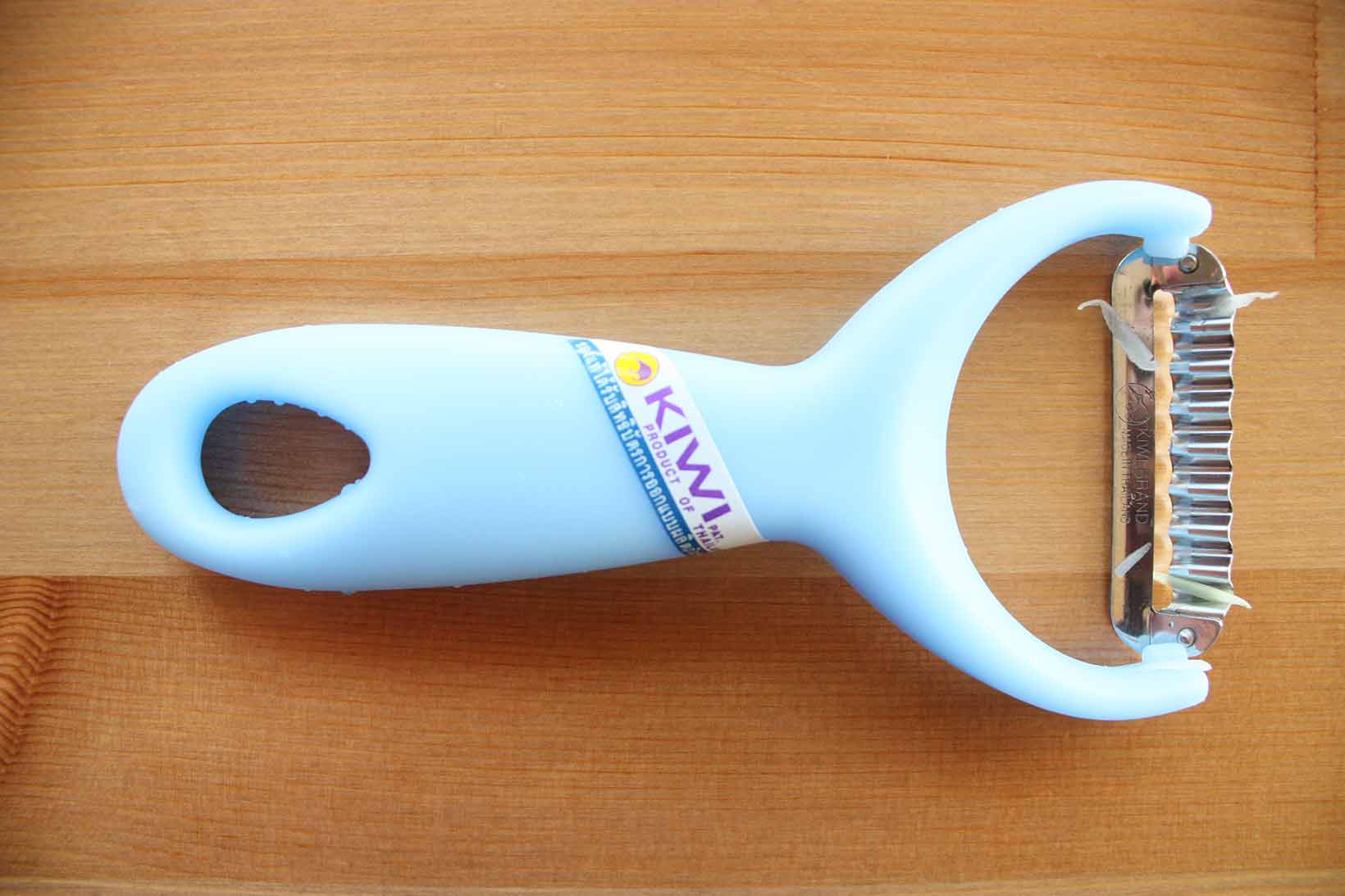 Using this peeler to slice papaya for a salad is a breeze; it works just like a julienne peeler:
Using this peeler to slice papaya for a salad is a breeze; it works just like a julienne peeler:
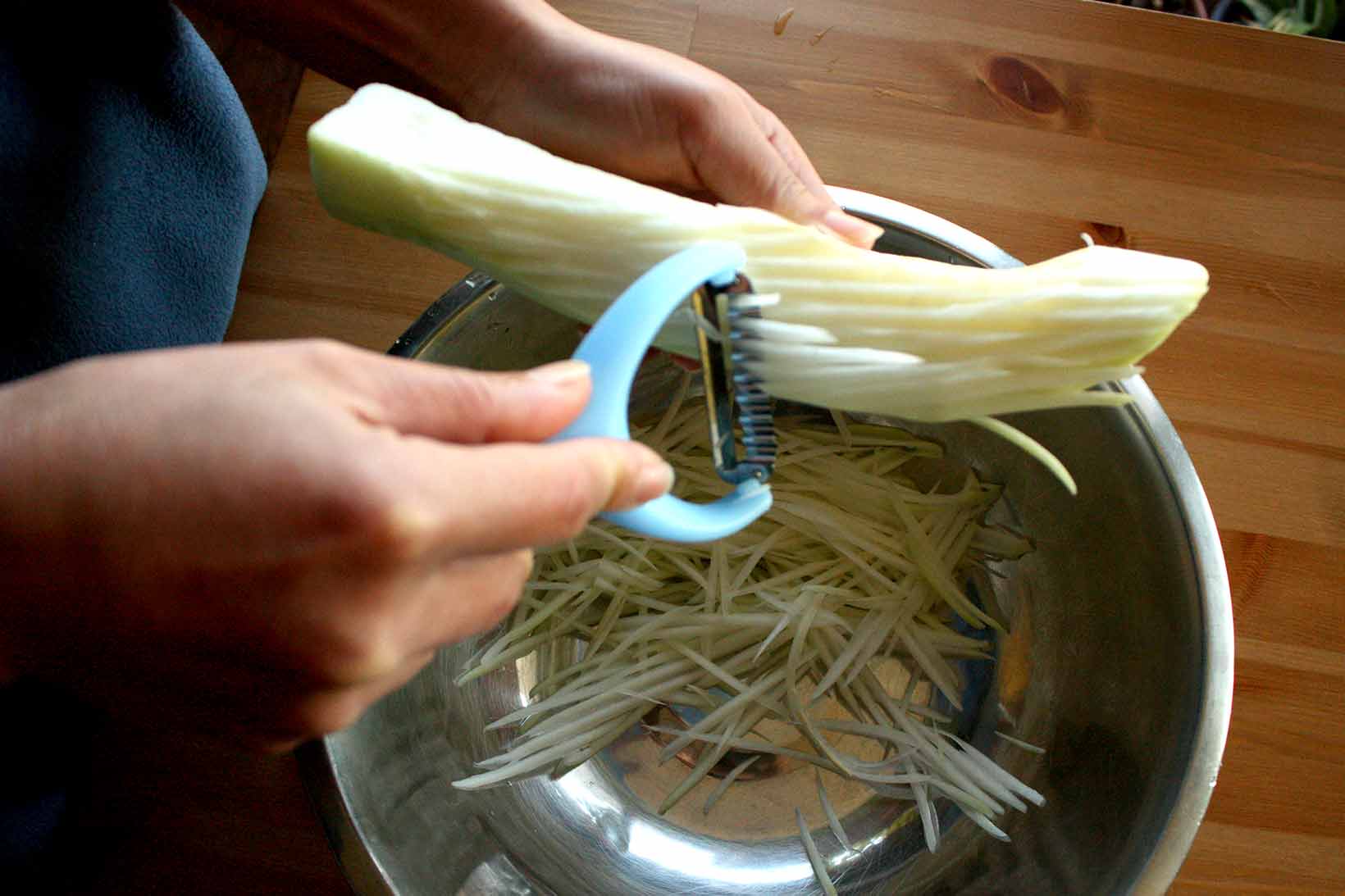
Nutrition
How to serve unripe papaya salad?
You can serve unripe papaya salad on its own, with rice, or with rice and barbecued meat of your choice. In Phnom Penh restaurants, bok lahong is generally served with grilled chicken wings. Meanwhile, in Thailand, you’ll find som tum served with sticky rice and various grilled meats or fried pork belly. If you want to make a quick salad to go with barbecued meat, you can also try this simple papaya side dish recipe, too.
What are the regional papaya salad varieties?
There are several regional papaya salad varieties, with distinctions between Cambodian, Thai, Lao, Vietnamese, and Burmese versions. We’ve shared a Cambodian version of papaya salad above, and below, we’ll explain the nuances that give papaya salad its distinct local flavors in Thai, Lao, Vietnamese, and Burmese interpretations. And since we’re only experts in Khmer food, we will also give you links to what we think are some of the best papaya salad recipes from the aforementioned countries.
Thai papaya salad
Thai-style papaya salad is quite similar to the bok lahong recipe with dried shrimp we’ve shared above. Instead of prahok, a Thai papaya salad may use pla ra — the Thai version of fermented fish. That said, most Thai salad recipes with papaya wouldn’t have carrots or kapi, and use tamarind juice as well as lime juice to produce the requisite acidity. Likewise, Thai papaya salad recipes may include Thai eggplant.
To prepare som tum salad, you would follow the same procedure we’ve described in our bok lahong recipe. You add ingredients gradually to the mortar and pound them with the pestle while tossing them with a spoon at the same time. If you’d prefer a vegetarian Thai papaya salad, follow the same steps but omit the dried shrimp and fish sauce, and opt for salt or soy sauce instead.
Thai green papaya salad recipes are ubiquitous on the internet, but this authentic som tum recipe (from an expert Thai chef!) is truly mouthwatering — and easy to prepare.
Lao papaya salad
Lao papaya salad is similar to the bok lahong with kapi we’ve shared in the recipe above. That said, the Lao version of the papaya salad (known as Tum Mak Houng in Lao) is quite unique as it’s made with padek sauce and crab paste. Padek is a thick, fermented freshwater fish sauce that’s a popular Laotian delicacy, and (along with crab paste) it adds a distinct aroma to the papaya salad. If you’d like to learn how to make Lao papaya salad from a Laotian expert, check out this recipe.
Vietnamese papaya salad
Vietnamese papaya salad (known as Gỏi Đu Đủ) is quite different from the Lao, Thai, and Khmer versions.
The most notable difference between Vietnamese green papaya salad and its counterparts from neighboring nations is the preparation method. Preparing Vietnamese salad from unripe papaya offers a departure from the mortar and pestle — the ingredients are shredded and tossed together in a large bowl.
Another key difference that give Vietnamese papaya salad its distinct flavor is the choice of protein. Whereas Cambodian, Thai, and Lao papaya salad all rely on seafood products (such as dried shrimp, shrimp paste, and fermented fish paste), Vietnamese green papaya salad is usually made with dried beef or cooked shrimp (or both).
The herbs used in Vietnamese papaya salad are also seldom seen (but possible) in the Thai, Khmer, or Lao versions of this dish. For example, Vietnamese recipes often call for mint and coriander leaves on top of the basil; these herbs afford the salad a uniquely Vietnamese, refreshing aroma. Likewise, fried shallots or onions further enrich the flavor profile of this salad — and make it so notably different from papaya salads served just across the border in Cambodia or Laos.
As we’re not experts in Vietnamese cuisine, we thought we’d share a link to an authentic Vietnamese papaya salad with beef jerky here.
Burmese papaya salad
Burmese papaya salad (known as Thin Baw Thee Thoke) is prepared without a mortar and pestle — the ingredients are shredded and tossed together. The primary components are quite different from those in the Thai, Khmer, and Lao papaya salads. There’s no dried or fermented seafood, and the Burmese version of the unripe papaya salad often includes fried onions, fried garlic, shallots, and palm, cane or brown sugar. Some Burmese chefs will also add green chillies, cilantro, tamarind, and roasted gram flour to the salad. So, if you’re after a vegan or vegetarian papaya salad recipe, the Burmese version is the one to try. You can learn how to make an authentic Burmese papaya salad by watching this video from an expert Burmese chef.
Can you make a vegan papaya salad?
Yes, you can make a vegan papaya salad.
You first option to make a vegan papaya salad is simply to remove the proteins, which most asian papaya salad recipes have. For example, if you follow the recipe for bok lahong we’ve shared above, you’d do away with fish sauce (substitute with salt or soy sauce), dried shrimp, kapi, and prahok. However, taking away these fermented seafood from the recipe will rid your salad of its unique, pungent aroma. So, as a solution, you can add a bit of fermented bean paste (to taste) — we’ve tried this, and the result was pleasantly delicious.
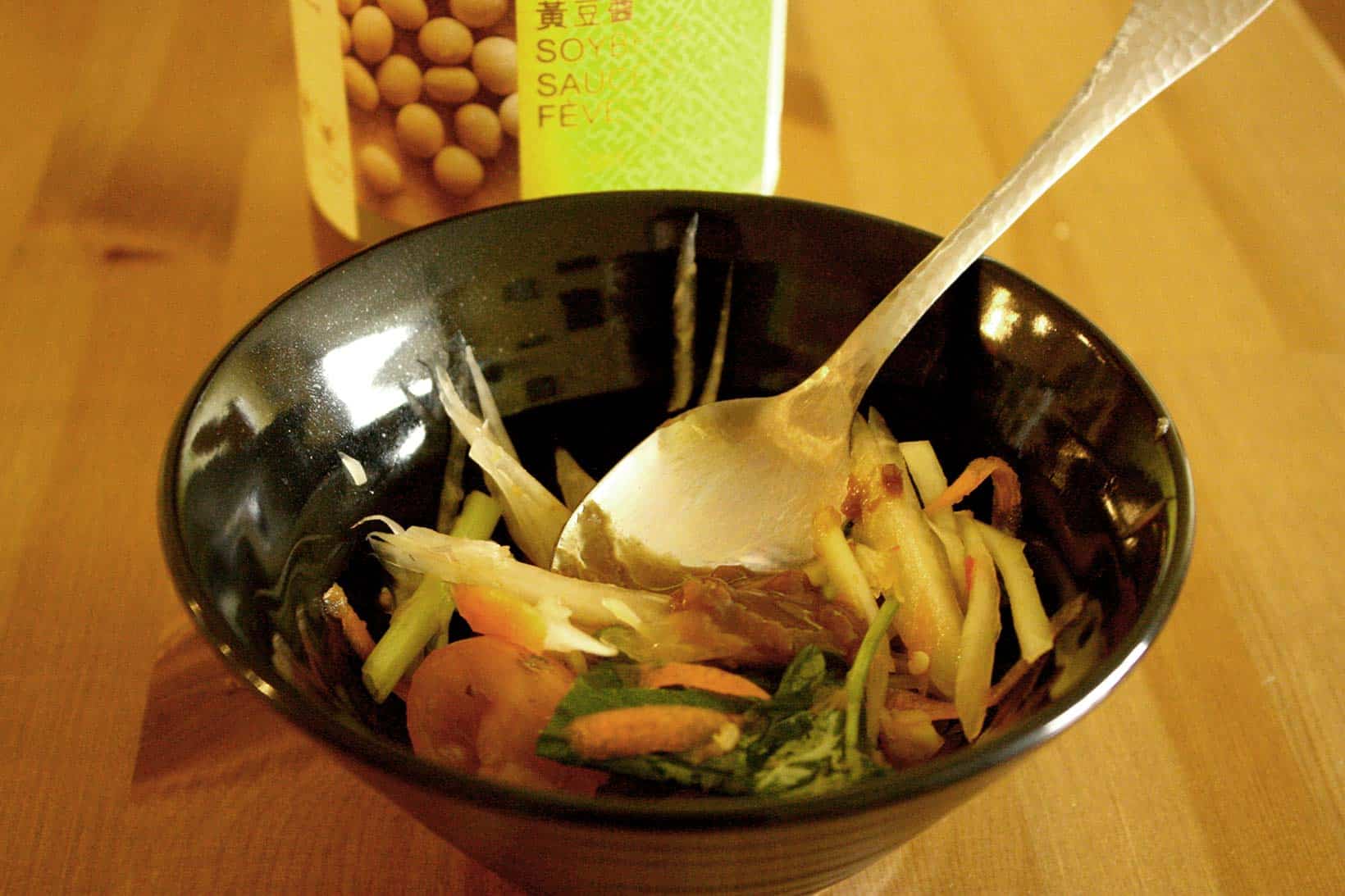
Your second option is to follow the Burmese papaya recipe, the link to which we’ve shared right above. None of the ingredients in this papaya salad contain any animal products.
How to make green papaya salad without a mortar and pestle?
To make green papaya salad without a mortar and pestle, you can either shred and toss the ingredients. If you’re following the bok lahong recipe we’ve shared in this post, the 7 steps below will help you prepare our papaya salad without a mortar and pestle.
- Mince or grate the garlic. You can use the flat side of a butcher knife to pound the garlic cloves, then mince them finely with the same knife. Alternatively, just scrape the garlic cloves on the fine grating side of the grater.
- Grate the papaya using the coarse grating side of the grater.
- Bruise the long beans with the flat end of a butcher knife (a rolling pin or empty wine bottle will do).
- Gently bruise the grape (or cherry) tomatoes with a butcher knife’s flat side. Be sure not to squish the tomatoes in the process.
- Chop the peanuts with a knife.
- Slice the chillies with a knife, then mix the papaya salad dressing (fish sauce, sugar, MSG, lime juice, and kapi or prahok).
- Mix everything together and let the ingredients sit in the marinade longer — in absence of a pestle’s pounding, you’ll want them to absorb the papaya salad sauce and soften up a bit.
What is green papaya salad made from?
Green papaya salad is made from unripe papaya, various vegetables, herbs, spices, and dried or fermented seafood products. The ingredients vary depending on the region. For example, Thai, Khmer, and Lao papaya salad is made with cherry tomatoes, and often includes long beans, Thai basil, garlic, dried shrimp and fermented fish or shrimp paste. Vietnamese papaya salad versions can be made with beef jerky, cooked shrimp, mint, and fried shallots or onions. Meanwhile, Burmese Thin Baw Thee Thoke can include jaggery, salt, roasted gram flour, and fried garlic and onions — but omit dried of fermented seafood products.
What type of papaya is used for green papaya salad?
Unripe papaya is used for green papaya salad. Don’t confuse unripe papaya with papaya that looks green. Green papayas are widely available in Asian grocery stores across the US. However, in most cases these papayas are actually yellow and semi-ripe inside — the producers ship them when they’ve already started to ripen but their skins haven’t turned yellow yet. If a seemingly green papaya feels soft to the touch, or is labelled as “red” or “orange,” it’s too ripe for you to use in a papaya salad.
Your best bet at finding a truly unripe papaya fruit is to head to an Asian supermarket. Unripe papayas are used in many Asian cuisines, and are usually abundant in asian stores that cater to the East and Southeast Asian diaspora.
To make sure that the papaya you’re getting is really unripe, feel it for firmness and weight. The firmer and heavier the fruit seems, the less ripe it is, and the more suitable it is for an authentic green papaya salad recipe.
Is papaya salad spicy?
Yes, papaya salad is spicy — at least if you’re buying one in Thailand, Cambodia, or Laos. The heat comes from its usual source — chilli peppers. The more of these peppers you put, the more you’ll sweat as you devour your spicy papaya salad. If punishing heat is your thing, go ahead and throw in 6-8 chillies into your portion. On the other hand, spicy food novices should stick to a single pepper — but make sure you’ve got at least one, or else you won’t have a genuine papaya salad. 4 chillies per portion will produce an average amount of heat, comparable to what you’d find in a Thai, Khmer, or Lao green papaya salad.
Is raw papaya salad healthy?
Yes, raw papaya salad is healthy if consumed in moderation. Unripe papaya is packed with vitamins and nutrients, including Vitamin A, Vitamin C, Vitamin E, antioxidants, folic acid, and high fiber content. These nutrients have numerous health benefits, including improved digestion, reduced inflammation, and an improved immune system. That said, unripe papaya has a latex content, and latex contains an enzyme called papain. In large amounts, papain can cause damage to the esophagus and stimulate contractions in pregnant women. For these reasons, women who are expecting and individuals with a latex allergy should avoid green papaya salad altogether, while the general population can consume the dish in moderation.
How long does papaya last in the fridge?
Papaya can last in the fridge for up to a week. However, once you’ve cut it, this duration will shorten to 3-5 days at best — cut papaya tends to lose freshness considerably faster than if you leave the fruit whole, so it’s best to prepare your papaya salad as soon as possible after cutting the fruit. If you’ve shredded the papaya in advance for making a papaya salad, you can keep it in the fridge for 24 hours before the bits start to go soft. And if you’ve already made the papaya salad, it’s best to eat it right away, or the marinade will cause the papaya to go soggy. In the event that you’ve made too much, you can keep the rest of the salad refrigerated for 3-4 hours.
Papaya Salad: Parting Words
We hope you’ll enjoy making (and eating!) our simple papaya salad recipe. And if you’ve prepared a papaya salad following recipe already — what did you think? Please leave a comment to share your thoughts with our readers and us.
